- Getting around Lijiang. Dont stay in the Old Towns more than 2 days, there is nothing to do. KRISS Oct 9, 2013 05:46
- 2013 Beijing Temple Fair BENNYLAU Feb 26, 2013 03:29
- Malaysian traveling from KUL - LAX vis Shanghai PVG ZATI_DY Jan 3, 2013 20:15
A Taoist Temple, A Lion Dance & The Forbidden City
- Views: 7237
- |Vote: 1 0
- |Add to Favorites
- |Recommend to Friends
Spring Festival Travel
The Chinese Spring Festival, literally translated from the Chinese 春节, may indeed have the word Spring in it’s title, but the truth is that in the Northern climes of China, winter is still very much in control.
Spring Festival, governed by the lunar calendar, falls in January or February every year and is the biggest festival in the Chinese year. As such, it’s just about common knowledge that travelling during this festival period presents foreign and domestic travellers alike with nothing short of a nightmare.
I am the first to agree with this, having taken a 19-hour hard-seat train journey from the Russia/China border to the province of Liaoning. I hadn’t thought it was possible to accommodate so many people on a train, every available space was crammed and at a couple of stations I had to physically cling to my fellow hard-seated passengers to avoid being swept off in a crush of luggage and limbs.
Sheer volumes of people make it impossible to buy tickets, hotels are overbooked with guests and, despite extra trains, planes and buses laid on to ameliorate the situation, the transport system really isn’t able to cope with demand.
However, if you avoid the few days leading up to the festival day itself, when it’s no exaggeration to say that millions are on the move, the post-Spring Festival weeks provide an interesting time to explore Beijing and mop up some of the lingering festive spirit.
[Image: Spring Festival Lanterns & Blue Sky]
A Cold Heart: The Forbidden City
The Beijing weather had dumped a healthy helping of snow the day before and turned on an electric blue sky for my few hours of exploring, but I still felt the Forbidden City to be a ghost town, eerily silent and sterile. Something about the wintry day seemed to agree with me.
The facts and figures about the Forbidden City speak for themselves: 14 years under construction, covering over 250 acres, home to 24 Chinese emperors up until the child emperor Puyi immortalised for me in the Bertolucci movie “The Last Emperor”. I would argue that the Forbidden City is realised in its finest hour in this recreation of the story of China’s rough and dangerous transition from imperialism to communism.
There are certain aspects of the Forbidden City that I’ve always been fascinated by. Not least that it was a completely closed and isolated world for most of its 500 years history. That at the heart of Beijing thrived a microcosm of power and intrigue zealously sealed-off from the real world, and the ordinary Chinese, by 10-meter high walls of red stone and a vast moat.
I personally found it very difficult to connect the intricacies of its past life with the open, empty spaces of its contemporary presence. Not unlike a museum piece, even though I was walking on the same ground that has experienced so much, I still felt there was a layer of glass between me and it.
I don’t blame the Forbidden City or the authorities for this condition, I think it’s a fact of the nature of the place. A city is to be peopled and lived in, not to be admired from afar as one would a great work of art. Therefore the Forbidden City couldn’t possibly deliver on my expectations of movie magnificence, offering up instead its huge cold heart.
[Image: Intricate Carvings & Designs: The Forbidden City]
Redeeming Features: The Forbidden City
Leave expectations at the front gate, if you can.
The Forbidden City is a masterpiece of architecture and design from the 17th and 18th Centuries, with over 9,000 rooms, large and small. The real beauty of the Forbidden City is in the details, if you can look beyond its great scale and see the individual pieces, then I think you can appreciate just how marvellous this place is.
Look beyond the mass of flat-topped, shallow-roofed palaces to the weird and wonderful creatures that adorn them. Look beyond the mustard-yellow tiles to the dragons carved upon them. Look beyond the white stone balustrades and steps to their intricately carved dragons and phoenixes. Look beyond the sparsely furnished rooms to the brightly patterned ceilings. Everywhere, in the details, there is real beauty.
There is also beauty in the stories of the Forbidden City. I remember the story of one emperor, Yongzheng who set up a system of a secret box called the “Heir Apparent Box”. The emperor himself would write and place the name of his successor in this box, and it would remain unopened, in the Palace of Heavenly Purity, until his death.
Initial disappointments aside, I was delighted by the gardens and the rear section of the Forbidden City where the emperor and his family actually “lived”. I loved the old trees whose bark was as delicately fashioned as any of the human-designed palaces. The closeness of buildings made the pathways here like a maze, criss-crossings of tall-walled corridors opened out into courtyards and tiny, colourful pavilions stepped out from behind craggy rock formations. I could well imagine the peace and romance of these gardens, a place for secret liaisons and meaningful glances.
Where the great spaces and formality of the Forbidden City seem to be more suited to film, it is in the gardens and family rooms where I found a real sense of what life here must have been like. I don’t believe a visit to Beijing would be complete without experiencing the Forbidden City.
[Image: Trees, Pavilions & Rocks: The Forbidden City]
Happiness, Wealth & Violent Death: East High Mountain Temple
East High Mountain Temple (东岳寺) is devoted exclusively to Laotzu (the Father of Taoism) and thanks to a restoration project, this temple first established in 1319 is now worth an hour or so of anyone’s time to look around. Even those who think they’ve seen every kind of temple China has to offer might find something new here. With the restoration of the temple comes its joint role as a Folk Custom Museum which means that amongst other things, it holds traditional performances of folk art from time to time, particularly during the major festivals.
The temple grounds are mainly contained within a large courtyard. The courtyard itself is edged with a dizzying number of “heavenly departments” each of which looks after a certain aspect of life. As this is a practising temple, you will see the odd Taoist monk looking slightly at odds amidst the mass of brightly dressed visitors, many of whom have come to ask for blessings by placing a red marker around the gate of the relevant department.
The “Department for Bestowing Happiness” (注福司) was easily the winner in terms of having hundreds of red markers. Next in line of popularity was the “Hall of Wealth”, a shrine to the Civil God of Wealth and the Military God of Wealth whose job of “making profits on a fair competition basis in any commercial transaction” sounds vaguely familiar. I would venture the incense there never burns out.
My favourite department, without question, is the “Department for Implementing 15 Kinds of Violent Death”. It’s not so bizarre as it sounds and allies itself with the branch of Taoist doctrine that believes those who commit evil deeds will be punished by dying any one of numerous “violent” deaths. Naturally, a heavenly department needs to oversee this.
I feel obliged to list all 15 variations, which are as follows, death by: starvation, clubbing, revengeful murder, battle, fierce animal, snakes, fire, flood, poisoning, madness, falling into an abyss, tricks of an evil friend, ghosts, incurable disease or suicide. Not surprisingly, no-one had been praying at this particular department when I visited.
The temple also contains a “garden” of stone steles and an interesting indoor museum dedicated to various folk customs. There are plenty of information signs in English too.
[Image: The Hall of Wealth is Busy]
A Fair, Lions & Acrobats: East High Mountain Temple
The temple itself was holding a fair when I was there during the Spring Festival. The fair was rather like a market: a long chain of stalls set up and snaking through the temple grounds.
Some of the stalls were selling folk arts and souvenirs and I couldn’t resist buying a colourful and highly impractical windmill made from wood and fabric. The winter wind catching in the bright sails, turned the wheel and a little wooden hammer made a satisfying clicking sound.
Many parents had bought them for their children and I asked one Chinese woman how much she had paid, before setting off to negotiate on buying mine!
Food stalls sold an array of local snacks and hot drinks. I can recommend the sweet Soya bean milk drink (豆浆) as a perfect winter warmer.
By a stroke of luck I caught a glimpse of some men in costumes and made my way to the street entrance of the temple. I didn’t know it but I was about to have one of my dreams fulfilled: after two years in China I was to watch my first Lion Dance.
For over 1000 years the Lion Dance has been bringing luck, joy and happiness to rural communities in China. Now it brings the same qualities to weddings, business openings and Spring Festival crowds. The Lions performing were in the Northern tradition, with two men supporting each lion, one as the front half controlling the head, and one as the back half.
I was sure I’d received my portion of luck just by being there and seeing it.
To a rousing, thrumming beat played by three musicians on a drum, a cymbal and a gong, the three lions performed a vigorous and energetic routine. They jumped, bounded and climbed over each other and when they stood on their hind legs I had to remind myself that in effect one man was sitting on the other’s shoulders. Their dance required no small amount of balance and skill and the huge crowd that had gathered on the street gave them a rousing reception as they finished.
To follow was another performance of singers and dancers and acrobats. Although I don’t know what it was that they were performing, I was still very impressed. A combination of many factors made it memorable: the rich make-up and costumes, the unique musical accompaniment, the amazing feats of balance and acrobatics, the expressive voices and actions of the performers themselves.
It was a visually extravagant pair of performances and even though my feet were freezing I stood applauding for some time, with the festively appreciative crowd, until the performers at last disappeared.
[Image: The Versatile, Vivacious Lion Dance]
Useful Travel Information
The Forbidden City
In Chinese: gùgōng (故宫)
For current prices, historical facts & figures, check out our own TCG:
http://www.travelchinaguide.com/cityguides/beijing/forbidden.htm
Unesco Site Criteria and 360º panoramic photos of the site:
http://whc.unesco.org/en/list/439
The East High Mountain Temple
In Chinese: dōngyuè sì (东岳寺)
Getting There:
Take the underground/subway Circle Line and get off at cháoyángmén (朝阳门) Station, head East a few hundred metres along cháoyángmén dàjiē (朝阳门大街) and it’s on your left.
[Image: The “Garden” of Steles at East High Mountain Temple]



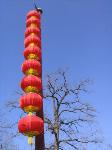
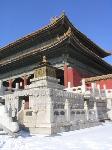
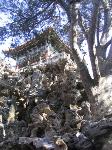
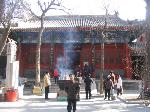
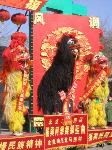
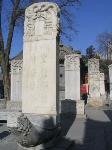
 Copyright © 1998-2025 All rights reserved.
Copyright © 1998-2025 All rights reserved.